The natural disaster detection IoT market is experiencing steady expansion driven by the increasing frequency of extreme weather events and growing emphasis on early warning and mitigation systems. Governments, research institutions, and private organizations are prioritizing IoT-based solutions to enhance situational awareness and disaster preparedness. Current market momentum is supported by integration of advanced sensors, real-time analytics, and cloud-based monitoring platforms that enable faster and more accurate data interpretation.
The adoption of AI and machine learning in predictive modeling has improved risk assessment and response coordination. Future growth is expected to be driven by public-private partnerships, investments in smart city infrastructure, and regional programs promoting digital resilience.
The market’s expansion is further underpinned by regulatory initiatives emphasizing disaster management frameworks and interoperability standards Overall, the combination of technological innovation, increasing data-driven decision-making, and heightened global awareness is expected to sustain strong demand for IoT-enabled disaster detection systems throughout the forecast period.
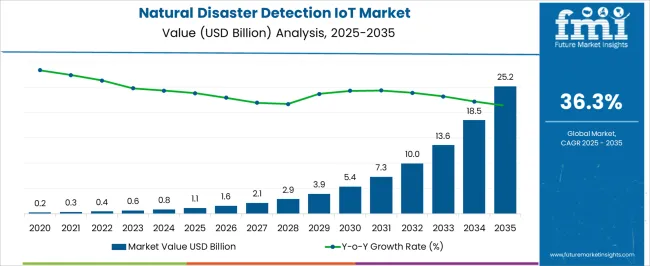
| Metric | Value |
|---|---|
| Natural Disaster Detection IoT Market Estimated Value in (2025 E) | USD 1.1 billion |
| Natural Disaster Detection IoT Market Forecast Value in (2035 F) | USD 25.2 billion |
| Forecast CAGR (2025 to 2035) | 36.3% |
The market is segmented by End User and Application and region. By End User, the market is divided into Government Organizations, Private Companies, Law Enforcement Agencies, and Rescue Personnel. In terms of Application, the market is classified into Weather Monitoring, Flood Detection, Drought Detection, Earthquake Detection, Landslide Detection, Wildfire Detection, and Others. Regionally, the market is classified into North America, Latin America, Western Europe, Eastern Europe, Balkan & Baltic Countries, Russia & Belarus, Central Asia, East Asia, South Asia & Pacific, and the Middle East & Africa.
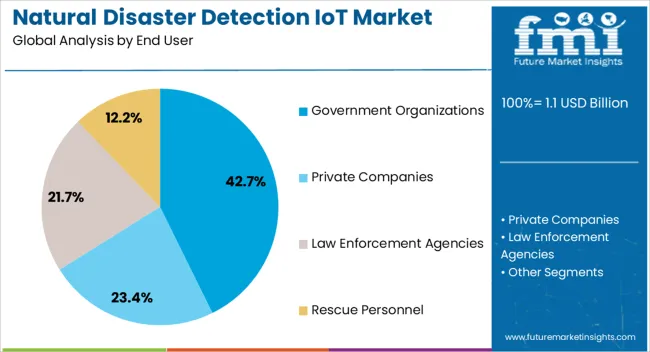
The government organizations segment, accounting for 42.70% of the end user category, has been leading due to its central role in national disaster preparedness and response operations. Adoption has been supported by large-scale deployment of IoT-based monitoring networks for early warning systems, seismic activity tracking, and emergency response coordination.
Public funding and international collaborations have enabled the development of integrated disaster management platforms that leverage IoT data for real-time decision-making. The segment’s growth is reinforced by policy frameworks prioritizing data transparency, citizen safety, and inter-agency connectivity.
Additionally, the expansion of smart city initiatives has driven governments to integrate IoT infrastructure for continuous environmental surveillance Ongoing investments in sensor networks, cloud integration, and predictive analytics are expected to enhance detection accuracy, operational readiness, and long-term sustainability of government-led disaster monitoring programs.
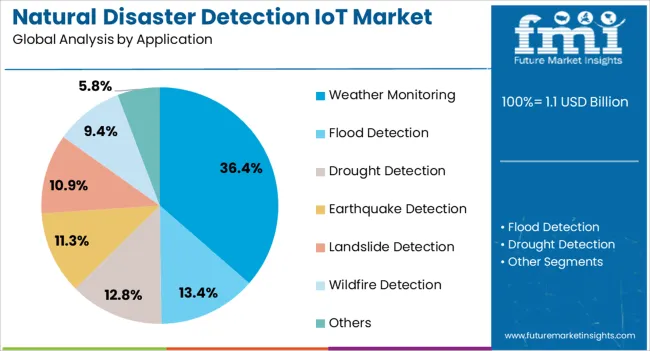
The weather monitoring segment, representing 36.40% of the application category, has emerged as the leading application due to its critical importance in forecasting and early warning systems. Increased volatility in global climate conditions has intensified demand for real-time atmospheric data collection and predictive modeling.
IoT-based weather monitoring systems provide continuous, high-resolution data that improve forecasting accuracy and enable proactive response planning. Integration with satellite imaging, radar networks, and edge computing has enhanced analytical capabilities, allowing faster alerts and better risk communication.
Market growth is also being supported by the deployment of low-power, long-range IoT devices capable of operating in remote or extreme environments Continuous advancements in data analytics, coupled with growing collaboration between meteorological agencies and technology providers, are expected to strengthen this segment’s contribution to disaster prevention and management efforts worldwide.
The global demand for the natural disaster detection IoT market was estimated to reach a valuation of USD 0.2 million in 2020, according to a report from Future Market Insights (FMI). From 2020 to 2025, the natural disaster detection IoT market experienced astounding growth, registering a CAGR of 41.4%.
| Historical CAGR from 2020 to 2025 | 41.4% |
|---|---|
| Forecast CAGR from 2025 to 2035 | 36.3% |
The increasing focus on preventive approaches to disaster management is another important driver. Governments and companies are prioritizing investments in modern technologies such as IoT in order to achieve early warning, fast reaction, and effective disaster mitigation.
This change from reactive to proactive approaches is driving the development of IoT solutions for natural disaster detection. The market for natural disaster detection IoT is expected to grow in the future due to these factors:
Proactive and Effective Disaster Detection Strategies to Enhance Market Growth
The growing frequency and intensity of natural disasters throughout the world is a major factor propelling the natural disaster detection IoT market. The need for IoT-based detection systems is fueled by governments, corporations, and communities investing in cutting-edge technological solutions for early detection, prediction, and mitigation as a result of this elevated risk perception.
The capability of IoT systems for detecting natural disasters to enable dynamic risk modeling is one of its distinctive features. These systems can produce dynamic risk models that adjust to shifting environmental conditions and offer precise insights into changing disaster scenarios by continuously gathering and analyzing real-time data from sensors. This allows for the improvement of preparedness and response efforts with previously unheard-of accuracy and effectiveness.
High Initial Deployment Costs to Impede the Market Growth
The significant initial expenses associated with implementing and maintaining IoT infrastructure are a major barrier to adoption, especially for smaller businesses with tighter budgets.
Since sensitive data is sent and kept, concerns about data privacy and security impede trust and adoption. Compatibility problems caused by interoperability problems across various IoT systems impede smooth integration and the achievement of the technology's full potential.
This section focuses on providing detailed analysis of two particular market segments for natural disaster detection IoT, the dominant end user and the significant application. The two main segments discussed below are the private companies and flood detection segments.
| End User | Private Companies |
|---|---|
| CAGR from 2025 to 2035 | 36.1% |
During the forecast period, the private companies segment is forecast to expand with a 36.1% CAGR. IoT technologies for detecting natural disasters are being widely used by private companies for a number of reasons. By protecting staff, infrastructure, and corporate assets from the damaging effects of disasters, these technologies provide business continuity and reduce financial losses.
Companies may improve their image and gain the confidence of stakeholders by investing in these technologies as a way to show their dedication to Sustainability and community resilience. Progressive risk management is made possible by the predictive powers of IoT devices, which lowers long-term liabilities and insurance costs.
| Application | Flood Detection |
|---|---|
| CAGR from 2025 to 2035 | 35.8% |
Through 2035, the flood detection segment is anticipated to register a 35.8% CAGR. Since this technology may give early warning signals and real-time monitoring, which are essential for reducing the destructive effects of floods, it is widely used for flood detection. IoT sensors have the ability to identify variations in water levels, which allows for early warnings to authorities and locals, enabling efficient resource allocation and evacuation.
Predictive modeling and advanced data analytics improve flood risk assessment, allowing for improved preparedness and response tactics that ultimately reduce property loss and save lives.
This section will go into detail on the natural disaster detection IoT markets in a few key countries, including the United States, the United Kingdom, China, Japan and South Korea. This part will focus on the key factors that are driving up demand in these countries for natural disaster detection IoT.
| Countries | CAGR from 2025 to 2035 |
|---|---|
| The United States | 36.6% |
| The United Kingdom | 37% |
| China | 36.9% |
| Japan | 37.6% |
| South Korea | 38.1% |
The United States natural disaster detection IoT ecosystem is anticipated to gain a CAGR of 36.6% through 2035. The United States is a center of technical innovation, notably in data analytics, artificial intelligence, and sensor technologies. Continuous improvements in these domains propel the development of increasingly complex and efficient IoT solutions for the detection and response to natural disasters, hence enhancing market expansion and competitiveness.
In addition to government funding, American private sector organizations, such as technology firms, insurers, and infrastructure developers, are investing more in IoT solutions for natural disaster detection. This investment is motivated by the realization that IoT technology has the ability to promote business continuity during natural catastrophes, lower damages, and improve risk management.
The natural disaster detection IoT market in the United Kingdom is expected to expand with a 37% CAGR through 2035. The need for advanced IoT solutions for natural disaster identification and mitigation is being driven by increased knowledge of climate change and its possible effects on extreme weather occurrences. Increased investment in technology and innovation is prompted by this awareness in order to improve early warning systems and disaster resilience.
Strict laws and guidelines pertaining to emergency preparedness and public safety promote the usage of IoT-based detection devices in the United Kingdom. The market may rise as a result of government efforts and industry standards mandating the use of modern technologies for better monitoring and response to catastrophic events.
The natural disaster detection IoT ecosystem in China is anticipated to develop with a 36.9% CAGR from 2025 to 2035. The emphasis of the Chinese government on disaster risk reduction and response approaches has boosted investment in IoT technologies for natural disaster detection.
Opportunities for the development and implementation of IoT solutions across the nation are created by policies targeted at improving early warning systems and disaster preparation.
The rapidly expanding infrastructure and urbanization in the country make its densely inhabited areas more susceptible to natural disasters. The market is expanding as a consequence of the rising need for sophisticated IoT-based detection systems to reduce hazards and enhance urban disaster response capabilities.
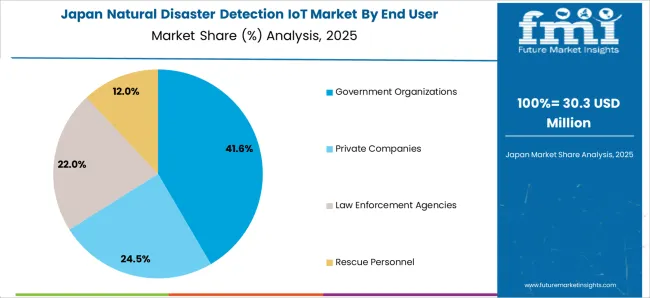
The natural disaster detection IoT industry in Japan is anticipated to reach a 37.6% CAGR from 2025 to 2035. Japan is well known for its advanced technology industry, which involves developing innovative IoT disaster detection systems. The acceptance and ongoing development of IoT-based early warning and disaster management systems are fueled by this innovation-focused approach.
Strong detection and warning systems are vital, as demonstrated by Japan's history of frequent and catastrophic natural catastrophes including typhoons, tsunamis, and earthquakes. The national proactive approach to disaster preparedness creates an atmosphere that is favorable for the growth and expansion of the IoT market for natural catastrophe detection.
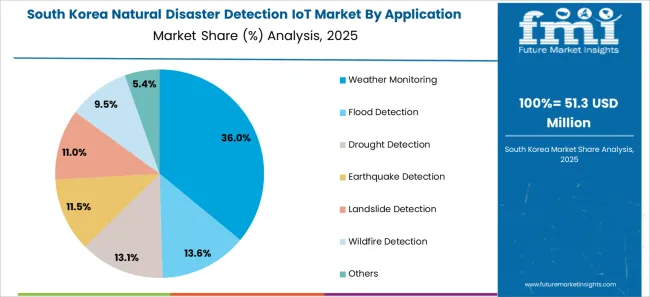
The natural disaster detection IoT ecosystem in South Korea is likely to evolve with a 38.1% CAGR during the forecast period. Adoption and progress of IoT technologies for natural disaster detection and management are driven by strong government support and investment in technology infrastructure and catastrophe resilience initiatives.
The susceptibility of the region to natural catastrophes like earthquakes, typhoons, and landslides necessitates the development of advanced IoT-based detection systems to increase early warning capabilities and lessen the effect of these occurrences.
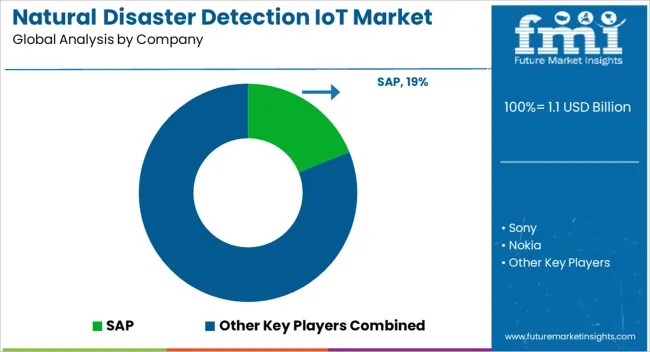
Key companies in the global natural disaster detection IoT market are actively involved in a number of strategic initiatives. Along with the development of sophisticated algorithms for real-time risk assessment as well as early warning systems, they place a high priority on the improvement of sensor technologies to maximize data collecting and processing.
While significant expenditures in research and development fuel innovation in disaster warning approaches, cooperative efforts with governments and non-governmental organizations are crucial to the implementation of IoT solutions in susceptible locations.
In order to support international disaster management efforts, these businesses are expanding their geographic presence to include additional disaster-prone areas and providing full-service solutions including data analytics and consulting. The key players in this market include:
Significant advancements in the natural disaster detection IoT market are being made by key market participants, and these include:
| Report Attribute | Details |
|---|---|
| Growth Rate | CAGR of 36.3% from 2025 to 2035 |
| Market value in 2025 | USD 835.8 million |
| Market value in 2035 | USD 18.5 billion |
| Base Year for Estimation | 2025 |
| Historical Data | 2020 to 2025 |
| Forecast Period | 2025 to 2035 |
| Quantitative Units | USD million/billion for value |
| Report Coverage | Revenue Forecast, Company Ranking, Competitive Landscape, Growth Factors, Trends, and Pricing Analysis |
| Segments Covered | End User, Application, Region |
| Region Covered | North America; Latin America; Western Europe; Eastern Europe; South Asia and Pacific; East Asia; The Middle East & Africa |
| Countries Profiled | The United States, Canada, Brazil, Mexico, Germany, The United Kingdom, France, Spain, Italy, Poland, Russia, Czech Republic, Romania, India, Bangladesh, Australia, New Zealand, China, Japan, South Korea, GCC Countries, South Africa, Israel |
| Key Companies Profiled | SAP; Sony; Nokia; Blackberry; NEC Corporation; Intel; Venti LLC; One Concern; Sadeem Technology; OgoXe |
| Customization Scope | Available on Request |
The global natural disaster detection IoT market is estimated to be valued at USD 1.1 billion in 2025.
The market size for the natural disaster detection IoT market is projected to reach USD 25.2 billion by 2035.
The natural disaster detection IoT market is expected to grow at a 36.3% CAGR between 2025 and 2035.
The key product types in natural disaster detection IoT market are government organizations, private companies, law enforcement agencies and rescue personnel.
In terms of application, weather monitoring segment to command 36.4% share in the natural disaster detection IoT market in 2025.






Full Research Suite comprises of:
Market outlook & trends analysis
Interviews & case studies
Strategic recommendations
Vendor profiles & capabilities analysis
5-year forecasts
8 regions and 60+ country-level data splits
Market segment data splits
12 months of continuous data updates
DELIVERED AS:
PDF EXCEL ONLINE
Natural Antioxidant Market Size and Share Forecast Outlook 2025 to 2035
Natural Cosmetic Color Market Size and Share Forecast Outlook 2025 to 2035
Natural Food Preservatives Market Size and Share Forecast Outlook 2025 to 2035
Natural Polymer Market Size and Share Forecast Outlook 2025 to 2035
Natural Gas Analyzers Market Size and Share Forecast Outlook 2025 to 2035
Natural Mineral Oil Coolant Market Size and Share Forecast Outlook 2025 to 2035
Natural Synthetic Cytokinin (Anti-zeatin Riboside) Market Size and Share Forecast Outlook 2025 to 2035
Natural Food Flavors Market Size and Share Forecast Outlook 2025 to 2035
Natural Silicone Alternative Market Analysis - Size and Share Forecast Outlook 2025 to 2035
Natural Skincare Preservatives Market Analysis - Size and Share Forecast Outlook 2025 to 2035
Natural Surfactant Market Size and Share Forecast Outlook 2025 to 2035
Natural Bitterness Blockers Market Analysis - Size And Share Forecast Outlook 2025 To 2035
Naturally Fermented Food Market Size and Share Forecast Outlook 2025 to 2035
Natural Refrigerants Market Size and Share Forecast Outlook 2025 to 2035
Natural Ferulic Acid Market Size and Share Forecast Outlook 2025 to 2035
Natural Vitamin E Product Market Size and Share Forecast Outlook 2025 to 2035
Natural Oil Polyols NOP Market Size and Share Forecast Outlook 2025 to 2035
Natural Rubber Market Size and Share Forecast Outlook 2025 to 2035
Natural Language Processing in Finance Market Size and Share Forecast Outlook 2025 to 2035
Naturally Derived Fatty Alcohol Market Size and Share Forecast Outlook 2025 to 2035

Thank you!
You will receive an email from our Business Development Manager. Please be sure to check your SPAM/JUNK folder too.
Chat With
MaRIA